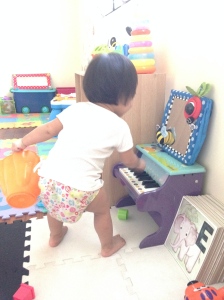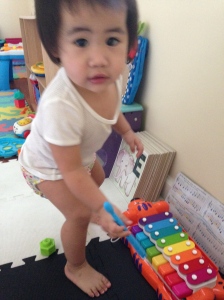Last Saturday, I joined Teacher Tina in her monthly segment at Anthony Pangilinan’s Mabago Tayo radio show. We talked about how to plan your child’s environment at home.
Teacher Tina, the directress of Nest School for Whole Child Development, a mom, and a fellow Family Life and Child Development Specialist, pointed out that planning your child’s space and time is crucial in developing important skills and promotes success later in life. To know more about this, you can read further on her website (teachertina.net).
Whenever we have visitors coming over to visit Ellie and Julia, I get questions such as: how did you come up with that kind of setup for Ellie’s room? Can I actually do that to my child’s room too? I also tell them that there is more to just making your child’s room look pretty or colourful. Although aesthetic is important, parents should always keep in mind that your child’s environment should be safe, developmentally-appropriate and one that invites learning, too.
In this article, I will discuss how you can make your child’s room into a learning environment. (In my succeeding articles, I will discuss how you can make it safe. :))
Before you read my tips, here’s a simple exercise I suggest you do:
1. While inside your child’s room, get down on your knees.
2. List down the things that you see from that level.
Why did I ask you to do this exercise? It is good to take the child’s perspective when planning your child’s environment. Did you actually see the walls and baseboards differently as compared to when you were standing? This only means that to fully understand your child’s environment, you need to see it from their level.
Here are some tips:
1. Plan a developmentally appropriate layout.
- Consider the size. The younger the child, the smaller the space around should be. For example, infants need a very confined space rather than a big one since they are still learning how to be mobile. On the other hand, toddlers definitely need lots of space as they need an environment that encourages independence and movement. They need a space to play that will encourage “active, creative, and whole-body play” (Mena& Eyer, 2009).
- Identify learning areas. Because children develop holistically, parents should provide for opportunities that will tap into the following developmental domains such as: physical, intellectual, social-emotional and consider the different learning styles (visual, bodily-kinesthetic, auditory). This is why your child’s room should be divided into these learning areas as well. You can set up the following: a reading area, an arts/crafts area, an area to dance/sing, an area to be alone/quiet, a manipulatives area (puzzle, blocks, etc), an area to explore self (various hats, costumes, masks, puppets).
- It is important that you put dividers to separate each learning area from each other. It also sends a particular message to younger children that there is a certain order to things and that certain things belong to a particular area. For example, you can setup low-open shelves where you can place the toys/materials per area. Young children can easily access these materials.
- The key to having a good arrangement is to have openness from your waist up so that you can supervise easily. Use storage spaces such as shelves or tables that are low and open.
- Make sure that walking paths are clear and there are nothing obstructing your child’s movements.
- Separate quiet areas from noisy areas. This means that your reading area, arts/writing area should be near each other while the manipulatives and housekeeping area should be beside each other.
- A gentle reminder: If you are living in house that is small and has limited space, you don’t have to worry because you can choose a certain space that you can allot for your child’s play area. Be resourceful by using existing furnitures to demarcate your child’s play space. You can also put labels that are color-coded to inform your child that this area is for cooking, or this area is for sleeping.
- Another suggestion is you can probably choose 2 learning areas per day that you can make your child explore and then choose another learning area/s for the other days. This way your child gets to explore different learning areas.
Here are some pictures of how I designed Ellie’s room. We are blessed to have quite a big space for her room. Since I only have one shelf in her room, I used rubber mats and Ellie’s learning materials/toys to set up boundaries per area. It helps because Ellie knows that in this particular area, she gets to read or she gets to explore musical instruments.
2. Choose developmentally appropriate materials
According to Mena & Eyer, “simple play objects and materials are best for infants.”. The kind of materials you will put in your child’s room depends on what your child can do at this stage. Of course, it also helps to put materials that your child is interested in. It is important to know what your child likes and does not like, together with identifying what is appropriate for his age.
For infants: the most interesting object is the live human face. Magda Gerber, the proponent of RIE (Resources for Infant Educarers) will tell you that infants need respect and we nurture infants best by interacting with them, more than overstimulating them with toys or anything that makes a sound.
For toddlers: Keep in mind the different learning areas (reading, music and movement, manipulatives/exploration, housekeeping and dramatic play) as well as the materials that are appropriate for your child.
You can also label the different materials because this already teachers your child that objects have names. For young children, you can label by putting pictures on the shelves where your materials are placed. By doing this, your child gets to practice sight reading and builds on early literacy skills.
For more information on appropriate play materials for your child, check out the Babies and Play Series on my blog.
3. Think about aesthetics and acoustics.
To create a space that is visually appealing, consider the lighting in your child’s room. Avoid the over lit effect of a fluorescent light. As much as possible if you can use natural lighting as this adds warmth to the place.
- Keep in mind colours and visual noise, as well.
- Make the background calm, warm and neutral to avoid overstimulating young children. According to Greenman, “with a neutral backdrop, the people, toys and materials stand out better, allowing children to find them and focus on them. The children are less distracted. “
- Provide softness in the room by adding carpets, cushions, cozy furnitures, soft blankets.
- If there is a choice, situate the room in an area that is far from background noises.
Louis Torelli explains, “A well-designed environment…supports infants’ and toddlers’ emotional well-being, stimulates their senses and challenges their motor skills…promotes children’s individual and social development”. Mena and Eyer (2009) points out that “infants and toddlers also get messages from the environment if it is well planned and consistent. In fact, learning to receive those messages is an important part of their socialisation process.” (p.264.)
Indeed, there is more to just making sure that your child’s room looks pretty or colourful.
Enjoy designing and planning!!! 🙂









Comments are closed here.